Crossings of the River Thames

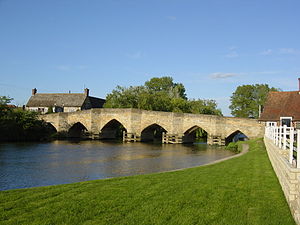
The crossings of the River Thames are numerous: over 200 bridges, 24 tunnels, six public ferries, one cable car link, and at least one ford. The River Thames has so many bridges thrown across it because of its position in the busiest part of the land, and the river has caused many of the great towns of the southern counties to grow, which in turn required a taming of the flood.
The river flows for 215 miles from its source to Southend Pier. In its upper reaches it is a modest river but it becomes navigable remarkably soon, at Cricklade, and the river below here is broad and a formidable barrier: all bridges must be such as will not hinder navigation, but the needs of navigation mean that until the river becomes tidal at Teddington, there are locks on its course, several of which provide a way to cross from one bank to another.
History of crossings
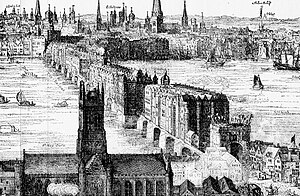
Many of the present road bridges over the river are on the sites of earlier fords, ferries and wooden structures. The Romans under Julius Caesar forded the river probably at Brentford, which would be a hazardous undertaking today; it is on a reach frequented by cargo ships. The earliest known bridges on the Thames were built by the Romans, at London Bridge and Staines Bridge. At Folly Bridge in Oxford the remains of an original Saxon structure can be seen, and mediæval stone structures such as Newbridge and Abingdon Bridge are still in use.
The growth of Kingston upon Thames in Surrey is believed to stem from its having the only crossing between London Bridge and Staines until the beginning of the 18th century.
Proposals to build bridges across the Thames at Lambeth and Putney in around 1670 were defeated by the Rulers of the Company of Watermen, since it would mean ruin for the 60,000 rivermen who provided a pool of naval reserve.[1] During the 18th century, many stone and brick road bridges were built from new or to replace existing structures, both in London and further up the river. These included Westminster Bridge, Putney Bridge, Datchet Bridge, Windsor Bridge and Sonning Bridge. Several central London road bridges were built in the 19th century, most conspicuously Tower Bridge, the only bascule bridge on the river, designed to allow ocean-going ships to pass beneath it.
The most recent road bridges are the bypasses at Isis Bridge and Marlow By-pass Bridge and the motorway bridges, most notably the two on the M25: Queen Elizabeth Bridge and M25 Runnymede Bridge.
The development of the railway resulted in a spate of bridge building in the 19th century including Blackfriars Railway Bridge and Charing Cross (Hungerford) Railway Bridge in London, and the spectacular railway bridges by Isambard Kingdom Brunel at Maidenhead, Gatehampton and Moulsford.
The world's first underwater tunnel was the Thames Tunnel by Marc Brunel built in 1843 and now used to carry the East London Line. The Tower Subway was the first railway under the Thames, which was followed by all the deep-level tube lines. Two road tunnels were built in East London at the end of the 19th century, the Blackwall Tunnel and the Rotherhithe Tunnel, and the latest tunnel is the Dartford Crossing.
Many foot crossings were established across the weirs that were built on the non-tidal river, and some of these remained when the locks were built – for example at Benson Lock. Others were replaced by a footbridge when the weir was removed as at Hart's Weir Footbridge. Around the year 2000, several footbridges were added, either as part of the Thames Path or in commemoration of the Millennium. These include Temple Footbridge, Bloomers Hole Footbridge, the Hungerford Footbridges and the Millennium Bridge (City of London to Southwark), all of which have distinctive designs.
Some ferries still operate on the river. The Woolwich Ferry carries cars and passengers across the river in the Thames Gateway and links the North Circular and South Circular roads. Upstream are smaller pedestrian ferries, for example Hampton Ferry and Shepperton to Weybridge Ferry; the latter is the only non-permanent crossing that remains on the Thames Path.
Listing bridges and crossings
The list below starts at the source and runs downstream, to the Thames Estuary. A few of the crossings listed are public pedestrian crossings using walkways across lock gates and bridges above or adjacent to the adjoining weirs.
Most of the other locks on the River Thames also have walkways across their lock gates and weirs, or one may walk with care across the top of the lock gates. However at many of the locks either the lock does not completely cross the river, or access is restricted to authorised personnel only, and are therefore such locks should not be listed.
Apart from bridges, tunnels and locks, the Thames has several ferries. Commuter boat services operate along some reaches of the river in London, and tourist boat services sail the river both in London and upstream, which services may bring the traveller to light at the other bank to continue his journey on foot.
Source to Cricklade
Not all of the bridges beyond Cricklade are listed below. For example, there are a number of small agricultural bridges allowing access between fields, and bridges to properties in Ashton Keynes that are not mentioned.
| Crossing | Type | Co-ordinates | Notes | |
|---|---|---|---|---|
| Gloucestershire and Wiltshire | ||||
| A433 Road Bridge, Fosse Way Roman Road | Road bridge | 51°41’24"N, 2°1’21"W | At Thames Head | |
| Wiltshire | ||||
| A429 Road Bridge | Road bridge | 51°40’47"N, 2°-0’53"W | ||
| Parker's Bridge, Ewen | Road bridge | 51°40’31"N, 2°0’25"W | ||
| Bridge south of Ewen | Road bridge | 51°40’27"N, 1°59’44"W | ||
| Neigh Bridge | Road bridge | 51°39’6"N, 1°58’29"W | ||
| Bridge | Road bridge | 51°39’2"N, 1°58’24"W | ||
| Footbridge | Pedestrian bridge | 51°38’59"N, 1°58’17"W | ||
| Bridge | Road bridge | 51°38’54"N, 1°58’8"W | ||
| Bridge | Road bridge | 51°38’52"N, 1°58’2"W | ||
| Bridge | Road bridge | 51°38’51"N, 1°57’58"W | ||
| Footbridge | Pedestrian bridge | 51°38’48"N, 1°57’46"W | ||
| Bridge | Road bridge | 51°38’43"N, 1°57’38"W | ||
| Bridges | Road bridge and pedestrian bridge | 51°38’46"N, 1°56’56"W | ||
| Bridge on B4696, Ashton Keynes | Road bridge | 51°38’46"N, 1°56’31"W | ||
| Bridge on Church Lane, Ashton Keynes | Road bridge | 51°38’48"N, 1°56’14"W | ||
| Bridge on Church Walk, Ashton Keynes | Road bridge | 51°38’48"N, 1°56’10"W | ||
| Bridge on Gosditch, Ashton Keynes | Road bridge | 51°38’42"N, 1°56’7"W | ||
| Bridge on The Derry, Ashton Keynes | Road bridge | 51°38’30"N, 1°55’56"W | ||
| Bridge on High Road, Ashton Keynes | Road bridge | 51°38’25"N, 1°55’51"W | ||
| Footbridge | Pedestrian bridge | 51°38’20"N, 1°55’25"W | ||
| Waterhay Bridge | Road bridge | 51°38’17"N, 1°54’53"W | ||
| Brook Farm bridge | Road bridge | 51°38’23"N, 1°54’14"W | North of Brook Farm, Waterhay | |
| Manor Farm bridge | Road bridge | 51°38’24"N, 1°54’10"W | North of Manor Farm, Waterhay | |
| Gloucestershire – Wiltshire | ||||
| Footbridge at Hailstone House | Pedestrian bridge | 51°38’57"N, 1°53’11"W | ||
| Midland and South Western Junction Railway bridge | Pedestrian and cycle bridge | 51°39’5"N, 1°52’31"W | Formerly a rail bridge | |
| Wiltshire | ||||
| Footbridge | Pedestrian bridge | 51°39’5"N, 1°52’31"W | ||
The river splits as it passes through Ashton Keynes. An alternative route to that listed above crosses High Bridge at 51°38’13"N, 1°55’46"W and Three Bridges at 51°38’18"N, 1°56’21"W
Cricklade to Oxford
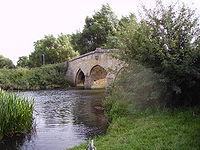

| Crossing | Type | Co-ordinates | Date opened | Notes |
|---|---|---|---|---|
| Wiltshire | ||||
| Cricklade Town Bridge | Road bridge | 51°38’40"N, 1°51’17"W | 1852 | |
| Cricklade sewage works bridge | Road bridge | 51°38’36"N, 1°51’5"W | Access road to sewage works, accessible to authorised personnel only | |
| A419 Road Bridge | Road bridge | 51°38’34"N, 1°50’43"W | 1988 | |
| Eysey Footbridge | Pedestrian bridge | 51°38’43"N, 1°50’18"W | ||
| Water Eaton House Bridge | Pedestrian bridge | 51°38’39"N, 1°49’21"W | ||
| Castle Eaton Bridge | Road bridge | 51°39’39"N, 1°47’33"W | 1893 | |
| Gloucestershire – Wiltshire | ||||
| Hannington Bridge | Road bridge | 51°39’48"N, 1°44’57"W | 1841 | |
| Footbridge | Pedestrian bridge | 51°41’18"N, 1°42’16"W | ||
| Halfpenny Bridge | Road bridge | 51°41’32"N, 1°41’34"W | 1792 | The start of the navigable Thames |
| Gloucestershire – Berkshire | ||||
| St John's Bridge, Lechlade | Road bridge | 51°41’22"N, 1°40’44"W | 1886 | |
| Bloomers Hole Footbridge | Pedestrian bridge | 51°41’15"N, 1°40’31"W | 2000 | |
| Buscot Lock | Lock and pedestrian bridge | 51°40’52"N, 1°40’6"W | ||
| Oxfordshire – Berkshire | ||||
| Eaton Footbridge | Pedestrian bridge | 51°41’6"N, 1°38’41"W | 1936 | |
| Radcot Bridge | Road bridge | 51°41’36"N, 1°35’19"W | 1787 | |
| Old Man's Bridge | Pedestrian bridge | 51°41’59"N, 1°34’5"W | 1868 | |
| Rushey Lock | Lock and pedestrian bridge | 51°41’54"N, 1°32’4"W | ||
| Tadpole Bridge | Road bridge | 51°42’5"N, 1°31’2"W | 1784 | |
| Tenfoot Bridge | Pedestrian bridge | 51°41’38"N, 1°29’23"W | 1869 | |
| Duxford Ford and Shifford Lock Cut footbridge | Ford and pedestrian bridge | 51°41’55"N, 1°27’58"W and 51°42’18"N, 1°28’14"W | The ford crosses the main river channel to an island formed by the Shifford Lock Cut; this is crossed by a footbridge | |
| Newbridge | Road bridge | 51°42’35"N, 1°25’2"W | 1250[2] | |
| Hart's Weir Footbridge | Pedestrian bridge | 51°42’24"N, 1°23’36"W | 1879 | |
| Pinkhill Lock | Lock and pedestrian bridge | 51°45’37"N, 1°21’52"W | ||
| Swinford Toll Bridge | Road bridge | 51°46’28"N, 1°21’33"W | 1777 | |
| A34 Road Bridge | Road bridge | 51°46’51"N, 1°18’11"W | 1961 | |
| Godstow Bridge | Road bridge | 51°46’47"N, 1°17’59"W | 1792 | A previous bridge was held by the Royalists in 1645. |
| Medley Footbridge | Pedestrian bridge | 51°45’50"N, 1°16’49"W | 1865 | |
Oxford to Reading
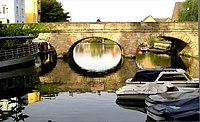


| Crossing | Type | Co-ordinates | Date opened | Notes |
|---|---|---|---|---|
| Oxfordshire – Berkshire | ||||
| Osney Bridge | Road bridge | 51°45’9"N, 1°16’21"W | 1885 | |
| Osney Rail Bridge | Rail bridge | 51°44’49"N, 1°16’1"W | 1850 and 1887 | Two adjacent bridges |
| Gasworks Bridge | Pedestrian bridge | 51°44’46"N, 1°15’49"W | 1882 | |
| Grandpont Bridge | Pedestrian bridge | 51°44’49"N, 1°15’39"W | 1930s | |
| Folly Bridge | Road bridge | 51°44’46"N, 1°15’23"W | 1827 | Stone bridge built 1085 |
| Donnington Bridge | Road bridge | 51°44’8"N, 1°14’31"W | 1962 | |
| Iffley Lock | Lock and pedestrian bridges | 51°43’46"N, 1°14’24"W | ||
| Isis Bridge | Road bridge | 51°43’30"N, 1°14’29"W | 1962 | |
| Kennington Railway Bridge | Rail bridge | 51°43’16"N, 1°14’32"W | 1923 | |
| Sandford Lock | Lock and pedestrian bridges | 51°42’30"N, 1°13’58"W | ||
| Nuneham Railway Bridge | Rail bridge | 51°40’9"N, 1°14’27"W | 1929 | |
| Abingdon Lock | Lock and pedestrian bridges | 51°40’15"N, 1°16’11"W | ||
| Abingdon Bridge | Road bridge | 51°40’7"N, 1°16’46"W | 1416 | |
| Culham Lock bridges | Pedestrian bridges | 51°38’58"N, 1°16’24"W | A bridge across the weir on the Culham Cut, west of Culham Lock; further south, other bridges cross the main river channel | |
| Sutton Bridge | Road bridge | 51°38’59"N, 1°15’56"W | 1807 | |
| Appleford Railway Bridge | Rail bridge | 51°38’38"N, 1°14’25"W | 1929 | |
| Clifton Hampden Bridge | Road bridge | 51°39’16"N, 1°12’38"W | 1867 | |
| Day's Lock bridges | Pedestrian bridges | 51°38’19"N, 1°10’47"W | ||
| Little Wittenham Bridge | Pedestrian bridge | 51°38’14"N, 1°10’49"W | 1870 | |
| Shillingford Bridge | Road bridge | 51°37’27"N, 1°8’22"W | 1827 | Replaced bridge built 1763. |
| Benson Lock bridge | Lock and pedestrian bridge | 51°36’59"N, 1°6’55"W | ||
| Wallingford Bridge | Road bridge | 51°36’3"N, 1°7’14"W | 1809 | Bridge recorded 1141. |
| Winterbrook Bridge | Road bridge | 51°35’18"N, 1°7’25"W | 1993 | |
| Moulsford Railway Bridge | Rail bridge | 51°33’29"N, 1°8’33"W | 1838 | |
| Goring and Streatley Bridge | Road bridge | 51°31’23"N, 1°8’33"W | 1923 | |
| Gatehampton Railway Bridge | Rail bridge | 51°30’42"N, 1°7’40"W | 1838 | |
| Whitchurch Bridge | Road bridge | 51°29’13"N, 1°5’6"W | 1902 | Toll bridge |
| Reading Festival Bridge | Pedestrian bridge (intermittently present) | 51°28’2"N, 1°-0’43"W | 2008 | Temporarily erected on permanent footings during the Reading Festival |
Reading to the Colne
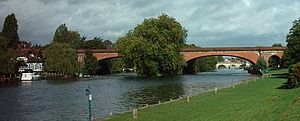
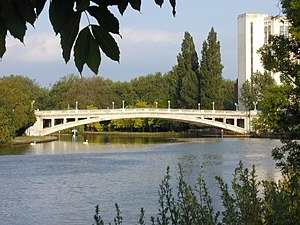
| Crossing | Type | Co-ordinates | Date opened | Notes |
|---|---|---|---|---|
| Oxfordshire – Berkshire | ||||
| Caversham Bridge | Road bridge | 51°27’57"N, -0°58’38"W | 1926 | Earliest bridge recorded 1231. |
| Reading Bridge | Road bridge | 51°27’39"N, -0°58’4"W | 1923 | |
| Caversham Lock | Lock and pedestrian bridge | 51°27’40"N, -0°57’54"W | 1875 | |
| Sonning Bridge and Sonning Backwater Bridges | Road bridges | 51°28’34"N, -0°54’54"W | c.1775 and 1986 | Earlier bridge recorded 1530 and one in 1125 |
| Shiplake Railway Bridge | Rail bridge | 51°30’7"N, -0°52’41"W | 1897 | |
| Henley Bridge | Road bridge | 51°32’15"N, -0°54’1"W | 1786 | Earlier bridge dates from at least 1232. |
| Buckinghamshire – Berkshire | ||||
| Hambledon Lock | Lock and pedestrian bridge | 51°33’34"N, -0°52’19"W | 1884 | |
| Temple Footbridge | Pedestrian bridge | 51°33’5"N, -0°47’49"W | 1989 | |
| Marlow Bridge | Road bridge | 51°34’2"N, -0°46’23"W | 1832 | Replaced bridge built in 1530. |
| Marlow By-pass Bridge | Road bridge | 51°33’58"N, -0°45’43"W | 1972 | |
| Bourne End Railway Bridge | Rail and pedestrian bridge | 51°34’30"N, -0°42’51"W | 1895 | |
| Cookham Bridge | Road bridge | 51°33’44"N, -0°42’22"W | 1867 | |
| Maidenhead Bridge | Road bridge | 51°31’25"N, -0°42’7"W | 1777 | Bridge recorded 1280. |
| Maidenhead Railway Bridge | Rail bridge | 51°31’16"N, -0°42’6"W | 1838 | |
| M4 Thames Bridge | Road bridge | 51°30’25"N, -0°41’10"W | 1961 | Carrying the M4 motorway; incorporates a footbridge |
| Summerleaze Footbridge | Pedestrian bridge | 51°29’59"N, -0°40’54"W | 1992 | |
| Queen Elizabeth Bridge, Windsor | Road bridge | 51°29’13"N, -0°37’22"W | 1966 | |
| Windsor Railway Bridge | Rail bridge | 51°29’13"N, -0°37’5"W | 1849 | |
| Windsor Bridge | Pedestrian and cycle bridge | 51°29’9"N, -0°36’30"W | 1850 | Formerly used as a road bridge |
| Black Potts Railway Bridge | Rail bridge | 51°29’33"N, -0°35’50"W | 1850 | |
| Victoria Bridge, Datchet | Road bridge | 51°29’16"N, -0°35’29"W | 1967 | Replacing an 1851 bridge |
| Albert Bridge, Datchet | Road bridge | 51°28’16"N, -0°35’4"W | 1928 | |
| M25 Runnymede Bridge | Road bridge | 51°26’15"N, -0°32’5"W | 1961 | Carrying the M25 motorway and, on the older part of the bridge, the A30; widened in 1983 and 2005 |
Proposed
- A pedestrian and cycle bridge is proposed between Reading and Caversham Bridges, to be located east of Fry's Island.[3]
Surrey / Middlesex to Teddington Lock
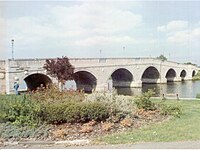
| Crossing | Type | Co-ordinates | Date opened | Notes |
|---|---|---|---|---|
| Middlesex – Surrey | ||||
| Staines Bridge | Road bridge | 51°25’60"N, -0°31’1"W | 1832 | Bridges recorded near this site since at least 1228. |
| Staines Railway Bridge | Rail bridge | 51°25’50"N, -0°30’40"W | 1856 | |
| M3 Chertsey Bridge | Road bridge | 51°23’39"N, 0°29’11"W | 1971 | Carrying the M3 motorway |
| Chertsey Bridge | Road bridge | 51°23’20"N, 0°29’11"W | 1785 | |
| Shepperton to Weybridge Ferry | Passenger ferry | 51°22’56"N, 0°27’25"W | 16th century | |
| Walton Bridge (1999) | Road bridge | 51°23’15"N, 0°25’53"W | 1999 | |
| Walton Bridge (1953) | Pedestrian and cycle bridge | 51°23’15"N, 0°25’52"W | 1953 | |
| Hampton Ferry | Passenger ferry | 51°24’43"N, 0°21’45"W | 1519 | From Hampton to Moulsey Hurst, East Molesey |
| Hampton Court Bridge | Road bridge | 51°24’13"N, 0°20’33"W | 1933 | |
| Kingston Bridge | Road bridge | 51°24’40"N, 0°18’33"W | 1828 | |
| Kingston Railway Bridge | Rail bridge | 51°24’49"N, 0°18’30"W | 1863 | |
Former
- The Datchet Bridge, built in 1707, was demolished in 1848.
Under construction
- A new bridge is being constructed to replace the Walton Bridges.[4]
The Tidal Thames to London
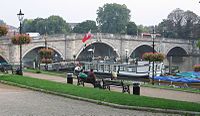



| Crossing | Type | Co-ordinates | Date opened | Notes |
|---|---|---|---|---|
| Middlesex – Surrey | ||||
| Teddington Lock Footbridge | Pedestrian bridge | 51°25’49"N, 0°19’19"W | 1889 | |
| Hammerton's Ferry | Passenger ferry | 51°26’48"N, 0°18’51"W | 1909 | From Marble Hill House (Twickenham) to Ham House (Ham) |
| Richmond Bridge | Road bridge | 51°27’27"N, 0°18’25"W | 1777 | |
| Richmond Railway Bridge | Rail bridge | 51°27’36"N, 0°18’49"W | 1848 | |
| Twickenham Bridge | Road bridge | 51°27’38"N, 0°18’51"W | 1933 | |
| Richmond Lock and Footbridge | Lock with pedestrian bridge | 51°27’44"N, 0°19’2"W | 1894 | |
| Kew Bridge | Road bridge | 51°29’14"N, 0°17’15"W | 1903 | |
| Kew Railway Bridge | Rail bridge | 51°29’3"N, 0°16’45"W | 1869 | |
| Chiswick Bridge | Road bridge | 51°28’23"N, 0°16’11"W | 1933 | |
| Barnes Railway Bridge | Rail and pedestrian bridge | 51°28’22"N, 0°15’14"W | 1849 | |
| Hammersmith Bridge | Road bridge | 51°29’18"N, 0°13’49"W | 1887 | |
| Putney Bridge | Road bridge | 51°28’1"N, 0°12’46"W | 1886 | Replaced an earlier bridge, opened in 1729 |
| Fulham Railway Bridge | Rail and pedestrian bridge | 51°27’57"N, 0°12’35"W | 1889 | |
| Wandsworth Bridge | Road bridge | 51°27’54"N, 0°11’16"W | 1938 | |
| Battersea Railway Bridge | Rail bridge | 51°28’23"N, 0°10’45"W | 1863 | West London Line. Also called the Cremorne Bridge. |
| Battersea Bridge | Road bridge | 51°28’52"N, 0°10’21"W | 1890 | Replaced an earlier bridge, opened in 1771 |
| Albert Bridge | Road bridge | 51°28’56"N, 0°10’0"W | 1873 | |
| Chelsea Bridge | Road bridge | 51°29’4"N, 0°8’59"W | 1937 | |
London and Westminster
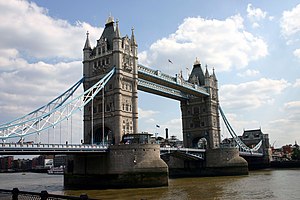


| Crossing | Type | Co-ordinates | Date opened | Notes |
|---|---|---|---|---|
| Middlesex – Surrey | ||||
| Grosvenor Bridge | Rail bridge | 51°29’5"N, 0°8’50"W | 1859 | Also known as Victoria Railway Bridge |
| Victoria line tunnels | Rail tunnel | 51°29’14"N, 0°7’39"W | 1971 | Between Vauxhall and Pimlico |
| Vauxhall Bridge | Road bridge | 51°29’15"N, 0°7’37"W | 1906 | |
| Lambeth Bridge | Road bridge | 51°29’40"N, 0°7’21"W | 1932 | |
| Westminster Bridge | Road bridge | 51°30’3"N, 0°7’19"W | 1862 | |
| Jubilee Line tunnels | Rail tunnel | 51°30’4"N, 0°7’18"W | 1999 | Between Waterloo and Westminster |
| Hungerford Bridge and Golden Jubilee Bridges | Rail and pedestrian bridges | 51°30’22"N, 0°7’13"W | 1864 and 2002 | Rail bridge flanked by newer pedestrian bridges |
| Northern line (Charing Cross branch) tunnels | Rail tunnel | 51°30’23"N, 0°7’10"W | 1926 | Between Waterloo and Embankment |
| Bakerloo Line tunnels | Rail tunnel | 51°30’24"N, 0°7’11"W | 1906 | Between Waterloo and Embankment |
| Waterloo Bridge | Road bridge | 51°30’31"N, 0°7’1"W | 1945 | |
| Waterloo & City Line tunnels | Rail tunnel | 51°30’35"N, 0°6’20"W | 1898 | Between Waterloo and Bank |
| Blackfriars Bridge | Road bridge | 51°30’35"N, 0°6’16"W | 1869 | |
| Blackfriars Railway Bridge | Rail bridge | 51°30’35"N, 0°6’12"W | 1886 | |
| Millennium Bridge | Pedestrian bridge | 51°30’35"N, 0°5’55"W | 2000 | |
| Southwark Bridge | Road bridge | 51°30’32"N, 0°5’39"W | 1921 | |
| Cannon Street Railway Bridge | Rail bridge | 51°30’30"N, 0°5’31"W | 1982 | |
| City & South London Railway tunnels | Disused rail tunnel | 51°30’29"N, 0°5’20"W | 1890 | This railway's original crossing of the river between Borough and King William Street; abandoned in 1900 when the Northern line City branch tunnels were opened on a new alignment |
| London Bridge | Road bridge | 51°30’28"N, 0°5’16"W | 1973 | Other bridges have stood on or near this site since around AD 50 |
| Northern Line (City branch) tunnels | Rail tunnel | 51°30’28"N, 0°5’13"W | 1900 | Between London Bridge and Bank |
| Tower Subway | Utility tunnel | 51°30’24"N, 0°4’46"W | 1870 | Formerly an underground railway (the world's first) - now used for water mains and telephone cables and accessible only by authorised personnel |
| Tower Bridge | Road bridge | 51°30’20"N, 0°4’32"W | 1894 | |
Former
- At least two Emergency Thames Bridges were erected as a precaution against enemy action during Second World War, both built in 1942 and demolished in 1948:
- From Victoria Embankment to County Hall
- Millbank
Docklands and Essex / Kent


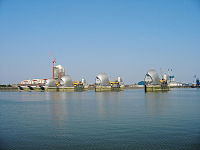
| Crossing | Type | Co-ordinates | Date opened | Notes |
|---|---|---|---|---|
| Middlesex – Surrey | ||||
| Thames Tunnel | Rail tunnel | 51°30’11"N, 0°3’16"W | 1843 | The world's first underwater tunnel, linking Wapping to Rotherhithe; now part of the London Overground network |
| Rotherhithe Tunnel | Road tunnel | 51°30’23"N, 0°2’55"W | 1908 | Single carriageway in each direction, with footways on each side. Built originally for horse-drawn carriages. Pedestrians, riders, cyclists are permitted, but advised to use alternatives due to fumes and speed. |
| Canary Wharf - Rotherhithe Ferry | Passenger ferry | 51°30’19"N, 0°1’47"W | ||
| Jubilee Line tunnels | Rail tunnel | 51°30’2"N, 0°1’48"W | 1999 | Between Canada Water and Canary Wharf |
| Docklands Light Railway tunnel | Rail tunnel | 51°29’5"N, 0°-0’37"W | 1999 | Between Island Gardens and Cutty Sark |
| Middlesex – Kent | ||||
| Greenwich Foot Tunnel | Pedestrian tunnel | 51°29’6"N, 0°-0’35"W | 1902 | |
| Jubilee Line tunnels | Rail tunnel | 51°30’1"N, 0°0’19"W | 1999 | Between Canary Wharf and North Greenwich |
| Blackwall Tunnel (western) | Road tunnel | 51°30’13"N, 0°0’14"W | 1897 | For northbound vehicular traffic only |
| Blackwall Tunnel (eastern) | Road tunnel | 51°30’19"N, 0°0’7"W | 1967 | For southbound vehicular traffic only |
| Essex – Kent | ||||
| Jubilee line tunnels | Rail tunnel | 51°30’17"N, -0°-0’31"E | 1999 | Between North Greenwich and Canning Town |
| Millennium Dome electricity cable tunnel | Utility tunnel | 1999[5] | Accessible by authorised personnel only | |
| Emirates Air Line | Cable car | 51°30’5"N, -0°-0’45"E | 2012 | |
| Thames Barrier | Flood barrier with pedestrian tunnel | 51°29’49"N, -0°2’14"E | 1984 | Service tunnel accessible by authorised personnel only |
| Woolwich Free Ferry | Vehicle ferry | 51°29’47"N, -0°3’44"E | 1889 | |
| Woolwich foot tunnel | Pedestrian tunnel | 51°29’47"N, -0°3’45"E | 1912 | |
| Docklands Light Railway tunnel | Rail tunnel | 51°29’55"N, -0°4’31"E | 2009 | Between King George V and Woolwich Arsenal stations |
Proposed or under construction
- A new rail tunnel is being constructed between Plumstead and North Woolwich as part of the Crossrail scheme.[6]
- The Silvertown Link is a proposed bridge or tunnel to relieve the Blackwall Tunnels between the Greenwich Peninsula and West Silvertown.
- The Gallions Reach Ferry is a proposed ferry service to replace the Woolwich Ferry, between Beckton and Thamesmead.
Thames Estuary
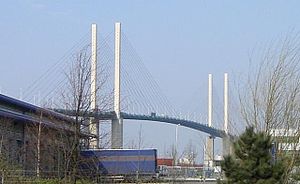
| Crossing | Type | Co-ordinates | Date opened | Notes |
|---|---|---|---|---|
| Essex – Kent | ||||
| Dartford Cable Tunnel | Utility tunnel | 51°28’5"N, -0°14’58"E | 2005 | Carrying electrical cable; accessible by authorised personnel only |
| Dartford Tunnels | Road tunnels | 51°27’55"N, -0°15’27"E | 1963 and 1980 | The northbound element of the Dartford Crossing |
| Queen Elizabeth II Bridge | Road bridge | 51°27’52"N, -0°15’31"E | 1991 | Cable-stayed bridge - the southbound element of the Dartford Crossing |
| High Speed 1 tunnels | Rail tunnel | 51°27’46"N, -0°17’37"E | 2007 | Two 1½-mile tunnels, 23½ feet internal diameter, between West Thurrock and Swanscombe |
| Gravesend–Tilbury Ferry | Passenger ferry | 51°26’55"N, -0°22’3"E | 1571 or before[7] | |
Proposed
A Lower Thames Crossing is proposed, at or east of the Dartford Crossing. Three options were announced in April 2009.
See also
References
- ↑ 'Parishes: Putney' - A History of the County of Surrey: Volume 4 (1912), pp. 78-83
- ↑ Thacker, Fred. S. (1920), The Thames Highway, 2, Locks and Weirs, p. 77
- ↑ "River Thames Reading footbridge consultation begins". BBC News. 16 April 2013. http://www.bbc.co.uk/news/uk-england-berkshire-22164236. Retrieved 5 July 2013.
- ↑ "Background to the proposed Walton Bridge". Surrey County Council. http://www.surreycc.gov.uk/roads-and-transport/bridges-and-structures/walton-bridge/background-to-the-proposed-walton-bridge. Retrieved 22 April 2012.
- ↑ Field, Gary (January 2000). "Monitoring settlement in London Clay". Converting Today. http://www.convertingtoday.co.uk/story.asp?storycode=551. Retrieved 22 April 2012.
- ↑ "Hochtief and Vinci win last Crossrail tunnels". The Construction Index. http://www.theconstructionindex.co.uk/news/view/hochtief-and-vinci-win-last-crossrail-tunnels. Retrieved 22 April 2012.
- ↑ Map drawn by a one-time Portreve (Mayor) of Gravesend, William Bourne, and included in The Book of Gravesham Sydney Harker, 1979 ISBN 0 86023 091 0]
- Tucker, Joan (2012). Ferries of the Upper Thames. Amberley Publishing. ISBN 9781848689671